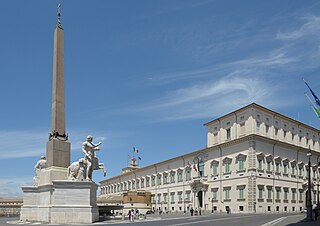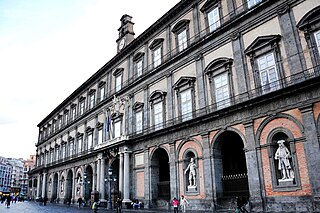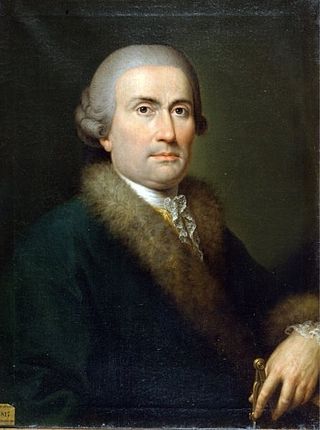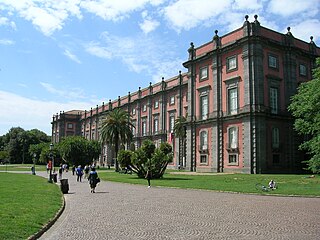
The Palace of Versailles is a former royal residence built by King Louis XIV located in Versailles, about 19 kilometers (12 mi) west of Paris, France. The palace is owned by the French Republic and since 1995 has been managed, under the direction of the French Ministry of Culture, by the Public Establishment of the Palace, Museum and National Estate of Versailles. About 15,000,000 people visit the palace, park, or gardens of Versailles every year, making it one of the most popular tourist attractions in the world.

The Château de Vaux-le-Vicomte (French pronunciation: [ʃato də vo lə vikɔ̃t] is a Baroque French château located in Maincy, near Melun, 55 kilometres southeast of Paris in the Seine-et-Marne department of Île-de-France.

The Quirinal Palace is a historic building in Rome, Italy, one of the three current official residences of the President of the Italian Republic, together with Villa Rosebery in Naples and the Tenuta di Castelporziano, an estate on the outskirts of Rome, some 25 km from the centre of the city. It is located on the Quirinal Hill, the highest of the seven hills of Rome in an area colloquially called Monte Cavallo. It has served as the residence for thirty popes, four kings of Italy and twelve presidents of the Italian Republic.

The Royal Palace of Caserta is a former royal residence in Caserta, southern Italy, constructed by the House of Bourbon-Two Sicilies as their main residence as kings of Naples. It is the largest palace erected in Europe during the 18th century. In 1997, the palace was designated a UNESCO World Heritage Site; its nomination described it as "the swan song of the spectacular art of the Baroque, from which it adopted all the features needed to create the illusions of multidirectional space". The Royal Palace of Caserta is the largest former royal residence in the world, over 2 million m3 in volume and covering an area of 47,000 m2 and a floorspace of 138,000 square meters in the distributed in the five storeys of the building.

Marble House, a Gilded Age mansion located at 596 Bellevue Avenue in Newport, Rhode Island, was built from 1888 to 1892 as a summer cottage for Alva and William Kissam Vanderbilt and was designed by Richard Morris Hunt in the Beaux Arts style. It was unparalleled in opulence for an American house when it was completed in 1892. Its temple-front portico resembles that of the White House.

The Palazzo Barberini is a 17th-century palace in Rome, facing the Piazza Barberini in Rione Trevi. Today, it houses the Galleria Nazionale d'Arte Antica, the main national collection of older paintings in Rome.

Caserta is the capital of the province of Caserta in the Campania region of Italy. An important agricultural, commercial, and industrial comune and city, Caserta is located 36 Kilometers north of Naples on the edge of the Campanian plain at the foot of the Campanian Subapennine mountain range. The city is best known for the 18th-century Bourbon Royal Palace of Caserta.

Renaissance Revival architecture is a group of 19th century architectural revival styles which were neither Greek Revival nor Gothic Revival but which instead drew inspiration from a wide range of classicizing Italian modes. Under the broad designation Renaissance architecture nineteenth-century architects and critics went beyond the architectural style which began in Florence and Central Italy in the early 15th century as an expression of Renaissance humanism; they also included styles that can be identified as Mannerist or Baroque. Self-applied style designations were rife in the mid- and later nineteenth century: "Neo-Renaissance" might be applied by contemporaries to structures that others called "Italianate", or when many French Baroque features are present.

The Royal Palace of Naples is a palace, museum, and historical tourist destination located in central Naples, southern Italy.
Giovanni Antonio Medrano was the "Major Regius Praefectus Mathematicis Regni Neapolitani", chief engineer of the kingdom, architect, brigadier, and teacher of Charles III of Spain and his brothers the infantes. Giovanni was a Sicilian born in Sciacca. Giovanni designed the Obelisk of Bitonto, the Palace of Capodimonte and the Teatro di San Carlo in Italy for Charles III of Spain. Medrano’s career is particularly studied, from his stay in Seville as a teacher for the royal princes, and his influence on Prince Charles’ architectural taste, to his projects in the kingdom of Naples or the royal palace at Capodimonte.

Palazzo Madama e Casaforte degli Acaja is a palace in Turin, Piedmont. It was the first Senate of the Kingdom of Italy, and takes its traditional name from the embellishments it received under two queens (madama) of the House of Savoy.

Giuseppe Piermarini was an Italian architect who trained with Luigi Vanvitelli in Naples and designed the Teatro alla Scala in Milan (1776–78), which remains the work by which he is remembered. Indeed, il Piermarini serves as an occasional journalistic synonym for the celebrated opera house. Piermarini was appointed professor in the Academy of Fine Arts of Brera, better known as Brera Academy, Milan, when it was formally founded in 1776.

The petit appartement du roi of the Palace of Versailles is a suite of rooms used by Louis XIV, Louis XV, and Louis XVI. Located on the first floor of the palace, the rooms are found in the oldest part of the palace dating from the reign of Louis XIII. Under Louis XIV, these rooms housed the king's collections of artworks and books, forming a museum of sorts. Under Louis XV and Louis XVI, the rooms were modified to accommodate private living quarters. At this time, the rooms were transformed and their decoration represent some of the finest extant examples of the Louis XV style and Louis XVI style at Versailles.

The Royal Opera of Versailles is the main theatre and opera house of the Palace of Versailles. Designed by Ange-Jacques Gabriel, it is also known as the Théâtre Gabriel. The interior decoration by Augustin Pajou is constructed almost entirely of wood, painted to resemble marble in a technique known as faux marble. The excellent acoustics of the opera house are at least partly due to its wooden interior.

The Palace of Venaria is a former royal residence and gardens located in Venaria Reale, near Turin in the Piedmont region in northern Italy. It is one of the Residences of the Royal House of Savoy, included in the UNESCO Heritage List in 1997.

The Royal Palace of Capodimonte is a large palazzo in Naples, Italy. It was formerly the summer residence and hunting lodge of the Bourbon kings of the Two Sicilies, one of the two royal palaces in Naples. Today, it comprises the National Museum of Capodimonte and the Royal Forest. The palace was constructed on its somewhat cooler hilltop location just outside the city, with urban Naples ultimately expanding around it.

Italian garden typically refers to a style of gardens, wherever located, reflecting a number of large Italian Renaissance gardens which have survived in something like their original form. In the history of gardening, during the Renaissance, Italy had the most advanced and admired gardens in Europe, which greatly influenced other countries, especially the French formal garden and Dutch gardens and, mostly through these, gardens in Britain.

The Royal Palace of Milan was the seat of government in the Italian city of Milan for many centuries. Today, it serves as a cultural centre and it is home to international art exhibitions. It spans through an area of 7,000 square meters and it regularly hosts modern and contemporary art works and famous collections in cooperation with notable museums and cultural institutions from across the world. More than 1,500 masterpieces are on display annually.




















